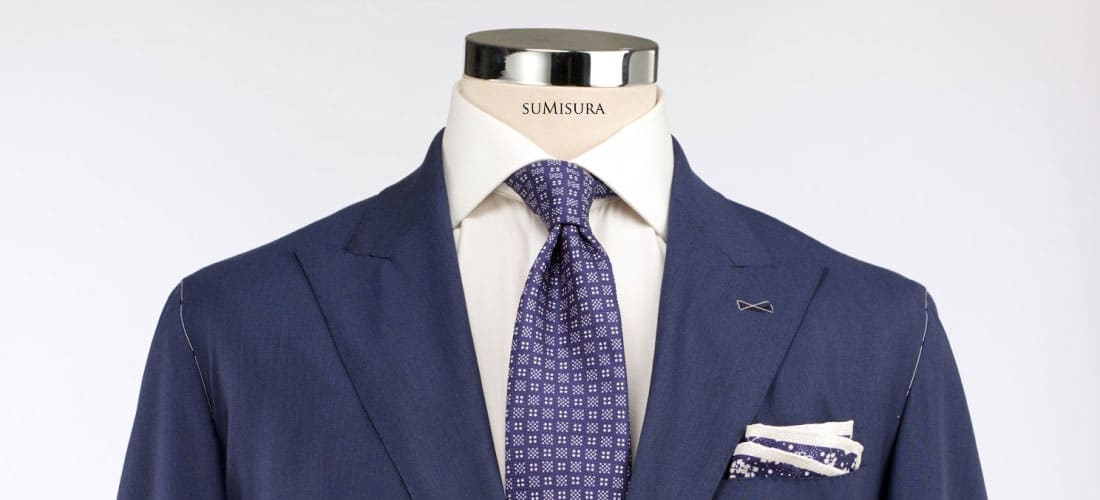Suit Means Business
Suit means “business”, and a good suit goes far beyond this sublimated message.
Buying it customised transports us to another dimension.
Understanding this concept is the basis for knowing how to order a bespoke suit
There are 4 keys to remember: Fact, Custom, “Business” and Dimension
The Fact
From a purist’s point of view, a classic suit is a set of 2 or 3 garments, including a waistcoat, made from the same fabric. If it’s tailor-made, it becomes a unique piece, made by a single individual who chose it, tried it on and approved it according to a wide range of criteria in terms of model, fabric, colour, fabrication and finish. The pinnacle of the men’s wardrobe.
The jacket.
Knowing how to order and talk about a jacket according to what you want from it is the first step towards its success. There are so many variables in order for the style to manifest itself and the work to be born.
The jacket can be a 1, 2 or 3-button jacket, or a more or less obvious buttoned jacket, from 2/1 to 6/2 i.e. 6 buttons of which 2 are buttoned. The width of the straps may be a question of fashion, but it goes beyond the ephemeral dictate. The jacket band should be harmonious with the width and height of the torso, and be accompanied by the same criteria for the collar and the width of the tie. The band must measure the same width as the base of a tie.
The bands can be flared or with an opening (the most common) between the collar and the band, as well as flounces for dinner jackets, which can be in the same fabric, velvet or silk.
It can be without openings, with a single opening in the middle or, most commonly, with two side openings that make it easier to reach into the pocket and still keep the back of the jacket straight. They became more popular when the change from horse to car took place.
Whether they’re made in continental England or the Mediterranean in Italy has to do with the type of climate and lighter or lighter construction, but also with the image you’re going for. If the former favours fabrics with more “body” and consistent interlinings, the latter favours lighter fabrics and construction, which doesn’t mean less elaborate, less refined or less excellent. It’s like preferring a car brand with a British or Italian soul.
In the classic jacket, 3 pockets are used, although 4 pockets are used in sports jackets. These 3 pockets consist of two side pockets and a breast pocket. While the breast pocket is the champion when it’s “in sight” – the most common pocket and should only be used to hold a silk, linen or woollen handkerchief – the side pockets can be with or without flaps, horizontal, slightly slanted or very slanted. The slope of the pockets, like the opening, is related to riding.
Don’t neglect the jacket’s inside pockets because, like all its other components, they each have a specific function. It’s therefore possible to comfortably store everyday utilities such as a wallet, diary, mobile phone, cigarette or bottle of hand sanitiser (so important today) inside a jacket.
The decoration of a jacket is its differentiation, sometimes its identity.
Stitching can be on the edge at 1mm (the most common) or 6mm, or even double 6mm for a bolder look, in the colour of the fabric or in contrast to make a statement. The buttonhole, in addition to the colour, also has quality and exception marks such as the sleeve buttonholes being open (a symbol of measurement) and the band eyelet being real or in Milanese stitching for a touch of distinction. Buttons should be chosen taking into account the wearer’s personality and the impact they want to have on each other. They can be made of polyester (the most common), change or horn, or more or less precious metals or stones.
The jacket also has its ceremonial aspects when it is worn to a wedding, christening or vernissage after five o’clock in the evening, and is upgraded to a dinner jacket or a jacket or white tie at a high ceremony that requires an appropriate dress code. In a coordinated version, i.e. where the garments are not all in the same fabric and colour, the French dinner jacket or American dinner jacket becomes a dinner-jacket. Until 5pm, in addition to the dinner jacket, the British morning suit, which we know as a dinner jacket, is also suitable.
Whether you’re wearing a city suit or a business suit, a leisure suit or a relaxed event suit, a travelling suit, a suit for an online business meeting or a ceremonial suit, choosing the right fabric is essential. In this respect, if you’re wearing a bespoke suit or looking for tailoring, it’s best to take the advice of your stylist or trusted tailor, who will know what’s most suitable after a chat about the performance you’re looking for and the investment available.
The trouser
The classic suit trouser is an extremely important item that requires just as much skill and knowledge to ensure that the “pair of trousers” fits as well as the jacket.
Without, with one, two or even three pleats, folded to the outside or inside of the vertical axis of the body, this is the first characteristic that stands out about the model. However, the application of French-style pockets (the most common) can also vary to the more commonly used Italian double welt or inset pocket, just as the vertical silk satin bar(s) on trousers in gala and ceremonial uniforms are important style factors, as are coin pockets, lighter or watch pockets or bank card pockets.
The waistband, high or low as you like, can have 6 or 8 drawstrings, or no drawstrings but with side or back loops, or be V-shaped for braces. When it comes to trousers, the waistband should be made of a good cotton fabric and the lining of a high quality mid-calf, which, along with a good cut, contributes to the best comfort.
More or less flared, with or without a hem – depending on personal taste or use – trousers meet fashion at their “drop”, here, at the hem. If it’s narrow, it should be above the ankle; if it’s wide, it can go down to the heel of the shoe.
The waistcoat
The classic suit waistcoat is not the least important of the three garments. Straight or crossed, without or with a band, with or without breast pockets, but always elegant when carrying a watch or some keys attached to a chain, the waistcoat enjoys the same decoration and details as its cousin the jacket. Sometimes in a co-ordinated version, it is the “Joker” that makes suits different and can add a touch of sophistication and good taste.
For the executive who likes to take his jacket off when he’s in the office, the waistcoat offers the possibility of having the same fabric on the back as on the front, which allows for greater elegance when in “shirt sleeves”.
BY MEASURE
In this key lies the quintessence of elegance. To be a bespoke suit is to be unique. It has a history lived by the tailor and the client, it has an identity that reflects a character and personality, it has a soul made of experience and tradition, made by the hands of skilful craftsmen and women who have produced it, and there are many. A good suit breathes the air of the Himalayas or the British Highlands, the spinning mill of Huddersfield or Biela and the expert hands of tailors and seamstresses who have given hours of their knowledge to the client’s desire.
Being “made to measure” is the fabric, pattern and colour that this desire expressed and the work was done, but it’s also the certainty that the suit respects the customer’s anatomy, bringing out their qualities and covering up what they want covered up, so that in the end the silhouette is perfect, balanced and harmonious.
A jacket has a waistline that must match the client’s, a sleeve elbow curve that must meet the client’s elbow, and a shoulder angle that must perfectly match the client’s body features. Only ready-to-wear suits are symmetrical and straight, like the mannequins that wear them in shop windows. The human body is dynamic and genetic, it has nuances of genetics, posture or acquired habits that only a bespoke suit can understand. The experienced eye of a bespoke stylist or tailor will know the exact height of the sleeves or hem, as well as how to distinguish a strong chest from a more discreet one, a rounder back or more developed shoulder blades, stronger thighs, knees that are more or less close together, among other ergonomic characteristics of each person, which are impossible to fill in at the ready and which make the latter the suit that “fits” and the former the suit that wears and fits well because it was made for just one person.
THE “BUSINESS”
“Business”, in inverted commas because it’s not business, it’s seriousness. “Business” implies seriousness, dedication and commitment. This notion of “business” communicates with the other(s) and gives excellence to the most important or the most futile, sporadic or daily events. The fact is “business” at work, in a social encounter, in seduction, in respect and admiration, in a special event, in an interview. Whenever we do something that calls for or deserves our best, the best ally is the suit, a herald of who we are that announces and exposes us in the right way.
DIMENSION
The fourth key closes this secret of bespoke dressing and is the one that opens the door to pleasure and sophistication for those who have their suit made – or any other item of clothing – declaring: “I’m going to my tailor to have a suit made”, as opposed to those who simply commoditise or buy on impulse: “I’m going to the shop to buy a suit”. Having a suit made is not an act of consumption at all. It’s a desire that is ordered and passed on between the client and the master of the trade and, in itself, this relationship is capable of elevating the social human being to another dimension and is capable of transforming the need to dress into an attitude of one’s own style and of communicating one’s best, anticipating a personality to the world. It is this elevation that transforms the act of dressing into a signature of one’s own style.
These are the basic principles of the classic suit and the main requirements and expressions to use when approaching a stylist or tailor to make bespoke happen, a term that will merit a dedicated article.

